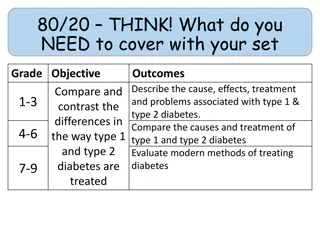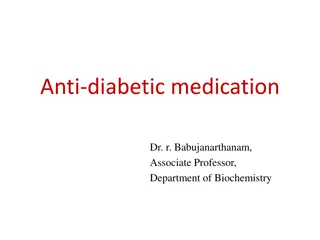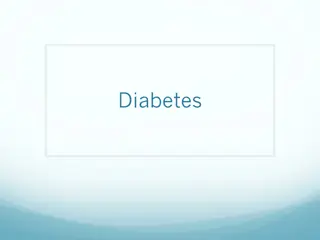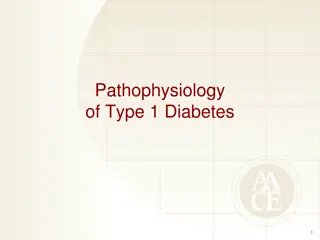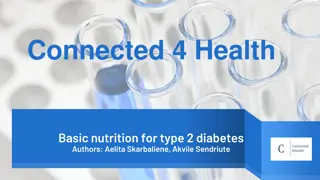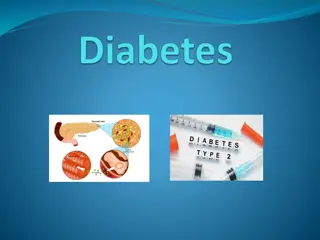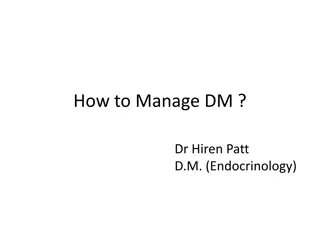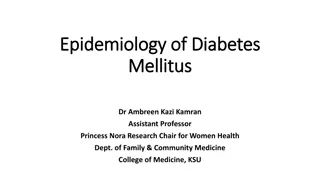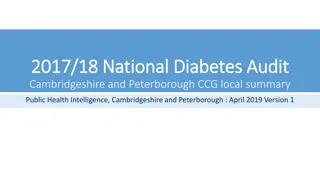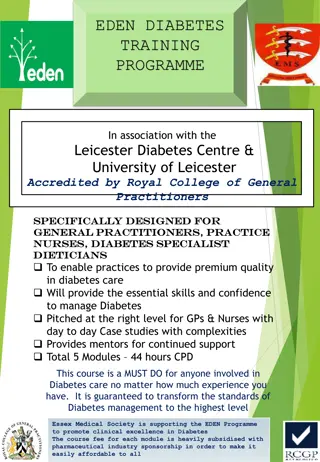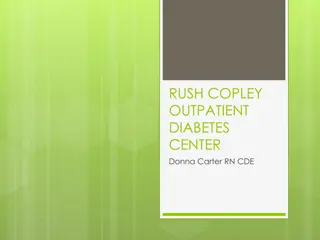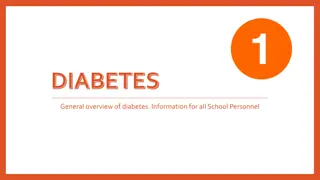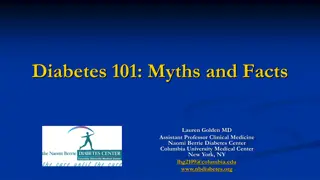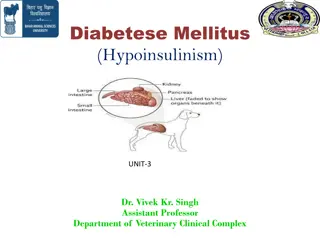Understanding Type 1 Diabetes: Causes, Symptoms, and Treatment
Type 1 diabetes is a condition where the pancreas fails to produce insulin, leading to high blood sugar levels. Without insulin, the body cannot use sugar for energy, resulting in various symptoms like hunger and fat burning. This article provides an overview of diabetes, how insulin works, and the physiology behind it. It also discusses the causes, symptoms, and basic treatment of Type 1 diabetes.
Download Presentation

Please find below an Image/Link to download the presentation.
The content on the website is provided AS IS for your information and personal use only. It may not be sold, licensed, or shared on other websites without obtaining consent from the author. Download presentation by click this link. If you encounter any issues during the download, it is possible that the publisher has removed the file from their server.
E N D
Presentation Transcript
What is Type 1 Diabetes? What is Type 1 Diabetes?
Session Objectives Define Diabetes Provide a brief overview of the way insulin is secreted and used in people without diabetes Discuss the cause of Type 1 Diabetes Review the symptoms and basic information about treatment of Type 1 Diabetes
What is diabetes? When a person has diabetes there is too much sugar (glucose) in the blood stream This happens because of a problem with the hormone INSULIN There are 2 different types of diabetes. Today we will focus on Type 1.
Normal Physiology (how the body works in someone WITHOUT diabetes) INSULIN unlocks the doors to our cells and lets glucose get in so that it can provide ENERGY We need ENERGY all of the time! The body knows just how much insulin to provide and when
Normal Physiology (how the body works in someone WITHOUT diabetes) There are 2 places that sugar comes from Liver Stores energy for use when we are not eating Eating We take in sugar (mostly in the form of carbohydrates), then it is digested in our stomach and absorbed into our blood stream
Normal Physiology (how the body works in someone WITHOUT diabetes) Sugar (Glucose) Cell Insulin Insulin ENERGY Insulin ENERGY ENERGY Insulin
Type 1 Diabetes In someone with Type 1 Diabetes the pancreas is no longer able to produce insulin Without insulin, the body cannot get sugar (glucose) into the cells for energy Builds up in the blood stream, leading to high blood sugar
Type 1 Diabetes Sugar (Glucose) Cell
Type 1 Diabetes The body has plenty of sugar, but without insulin it cannot be used for energy The child may feel HUNGRY The body looks for other ways to make energy and begins to burn fat This can be dangerous because it leads to a build up of acid in the blood
What Causes Type 1 Diabetes? Type 1 Diabetes is an AUTOIMMUNE disorder. This means that the body s own cells attack and destroy the beta cells in the pancreas that make insulin There is no single cause for diabetes A combination of genetics, environment, and viral illness are likely responsible We do know one thing for sure: There is nothing that a child or their family did to CAUSE Type 1 Diabetes. And there is nothing that can be done to prevent Type 1 Diabetes at this time
How do we know if someone has Type 1 Diabetes? The symptoms of diabetes include: Eating a lot (polyphagia) Drinking a lot (polydipsia) Peeing a lot (Polyuria) High sugar (glucose) levels or evidence of high glucose levels in the blood High levels of ketones in the urine Markers in the blood that indicate autoimmune destruction of the beta cells
How is Type 1 Diabetes Treated? Someone with Type 1 Diabetes will need to take injections of insulin under the skin every day There are no oral medications that can make insulin in the body for someone with Type 1 Diabetes We try to give insulin by injection to mimic the way a pancreas would give insulin Insulin can cause a low blood sugar, so patients also carry Glucagon, a rescue medication to use if their blood sugar gets dangerously low
Additional Resources AFCH Pediatric Diabetes Website Growing Up Healthy Blog: Type 1 101 Beyond Type 1 JDRF ADA Safe at School Training Videos Pink Panther Book (requires purchase)






